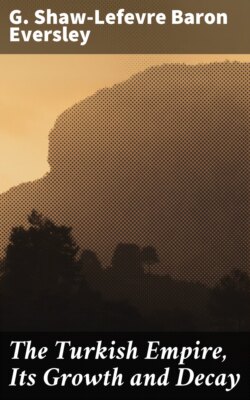Читать книгу The Turkish Empire, Its Growth and Decay - G. Shaw-Lefevre Baron Eversley - Страница 9
На сайте Литреса книга снята с продажи.
III
MURAD I
1359-89
ОглавлениеTable of Contents
Murad succeeded his father, Orchan, at the age of forty. He soon proved himself to be eminently qualified to rule by his untiring activity and vigour, his genius for war, and his wise and sane statesmanship. He was illiterate. He could not even sign his name. There is extant in the archives of the city of Ragusa a treaty with its petty republic, which Murad, in 1363, signed by dipping his hand in ink and impressing it with his finger marks. The ‘tughra’ thus formed became the official signature of subsequent Sultans of Turkey. Osman and Orchan between them created the Ottoman dynasty and State, but Murad must be credited with having founded the Empire in the sense of imposing Ottoman rule on subject races.
On Murad’s accession his territory, though greatly increased by Orchan, was less in extent than some other Turkish Emirates in Anatolia. It consisted of an area on both sides of the Sea of Marmora, two hundred miles in length by about one hundred in depth. It included both shores of the Dardanelles, but only one side of the Bosphorus. Constantinople, on the other side, though nearly hemmed in by the Ottomans, was nominally independent, and its communications with the Greek province of Thrace were still open. Deducting the area of the Sea of Marmora, the territory under Murad’s rule was not of greater area than twenty thousand square miles. Its population probably did not amount to a million in number. It is difficult to understand how Murad from this small territory so enormously increased his Empire in Europe. It may be surmised that large numbers of Turks from other parts of Anatolia flocked to his standard in search of adventure and booty in Europe.
The ownership of both sides of the Dardanelles did not, in the days before the invention of gunpowder, give command of the Straits, and as Murad was without a navy, the passage of his armies between Asia and Europe was at the mercy of any naval Power. The Genoese, who had important commercial settlements on the shores of the Black Sea and on the Bosphorus at Galata, and who maintained a large naval force in the Ægean Sea, might easily have barred the way of the Ottomans to Europe, but they hated the Greeks and were greedy of money, and they could be relied on to convey Murad’s armies across the Straits for a full consideration. It will be seen that Murad, during his reign of thirty years, increased by more than fivefold the Ottoman possessions, and at one point brought them up to the Danube. He compelled other States also, including the Greek Empire itself, to accept the position of tributaries to his Empire. His fame in Ottoman history must be regarded as on a level with that of Mahomet, the Conqueror of Constantinople, and of Solyman the Magnificent, who raised the Empire to its zenith.
Murad’s great extensions of his Empire may more conveniently, than in a chronological order, be treated under three distinct heads:—
1. His conquest of the possessions of the Greek Empire in Thrace and Bulgaria and the reduction of that decadent Empire to the humiliating position of vassalage. 2. His great conquests in Bulgaria, Macedonia, and Serbia. 3. His extensions in Anatolia by the absorption of Turkish Emirates or parts of them.
